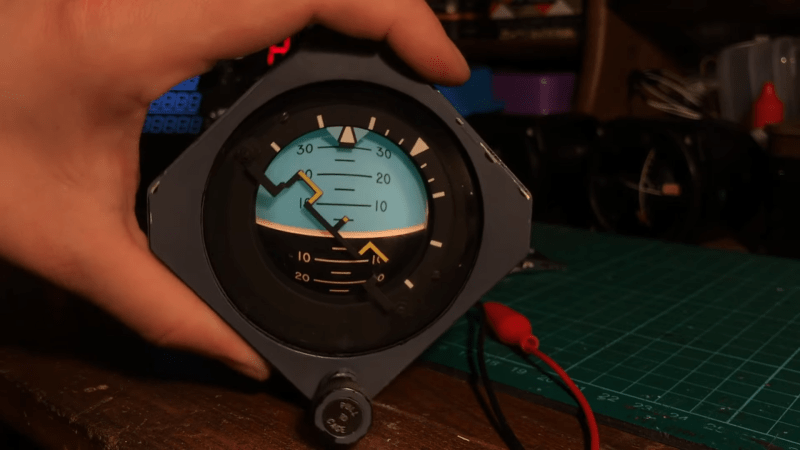Attitude indicators are super useful if you’re flying a plane, particularly in foggy conditions or over water. They help you figure out which way the plane is pointing relative to the unforgiving ground below. [Hack Modular] has been toying with a few, and even figured out how to get them powered up!
The attitude indicators use spinning gyroscopes to present a stable artificial horizon when a plane is in motion. Airworthy models are highly expensive, but [Hack Modular] was experimenting with some battered surplus examples. He sets about opening the delicate gauges, noting the seals and other features intended to protect the equipment inside. We get a great look at the gimbals and the reset mechanism used to zero out the device. He then pulls a classic mechanic’s trick, robbing a few screws from Peter to reassemble Paul.
We wouldn’t trust the gauges for flight duty, but they look great when powered up, all lit and spinning. They have the beautiful vintage glow that you only get from filament bulbs and deftly painted instrumentation. While avionics don’t come cheap off the shelf, it’s worth tinkering with cheap older gear if you can find it. The engineering involved, even in older equipment, is truly impressive. Video after the break.

















“They have the beautiful vintage glow that you only get from filament bulbs and deftly painted instrumentation.”
Absolutely. I hope that we get that back, eventually.
With new materials or luminous gases, maybe, filament bulbs might make a comeback, eventually.
It’s not just about nostalgia, but a simple matter of eye-friendliness.
Pilots should never have suffer from strained eyes, if it can be avoided.
So natural looking light sources, which provide a good light quality, are no waste.
Maybe highly-developed E-ink displays could get most of the way there eventually. There are, of course, massive issues around refresh rate right now, but one can always hope.
Very immersive, it makes so much noise it sounds like you’re in a plane.
Over on “Aviation” on StackExchange search for:
“How is a confusion possible between Western and Russian Attitude Indicators?”
On Western aircraft the “horizon bar” moves and the aircraft symbol is fixed to the plane.
On Russian aircraft the “horizon bar” is fixed to the plane, and the aircraft symbol moves.
The Crossair Flight 498 accident occurred, in part, to Russian-trained pilots confusion when flying a Western plane.
trochotron
noun
troch·o·tron ˈträkə‧ˌträn
plural -s
: 𝐚 𝐡𝐢𝐠𝐡-𝐯𝐚𝐜𝐮𝐮𝐦 𝐭𝐮𝐛𝐞 or a mass spectrograph in which the ion paths controlled by magnetic and electric fields are trochoids
I worked on that particular horizon. All the bearings need replacement. These need to spin up to 22,000 rpm to work right. You can get an air powered horizon and spool it up with a vacuum cleaner. Much simpler mechanism. Generally by the time gyro instruments need service, the bearings are all shot. I have a WWII Spitfire horizon that will spin up and erect, but the bearings howl like a banshee.
These are my favorite comments on hackaday. Thank you
Fun fact: modern gyros are actually pendulums.
Interesting. I was wondering why these were so complicated. It seems like a heavy-bottomed ball in a spherical shell or gimbals would be a much simpler and more robust approach… unless you were able to flip over instantaneously so that it could not capture the shift.
If it was weighted at the bottom you would get a pendulum effect. The ball itself weighs basically nothing. The gyro is balanced so that it has no bottom.